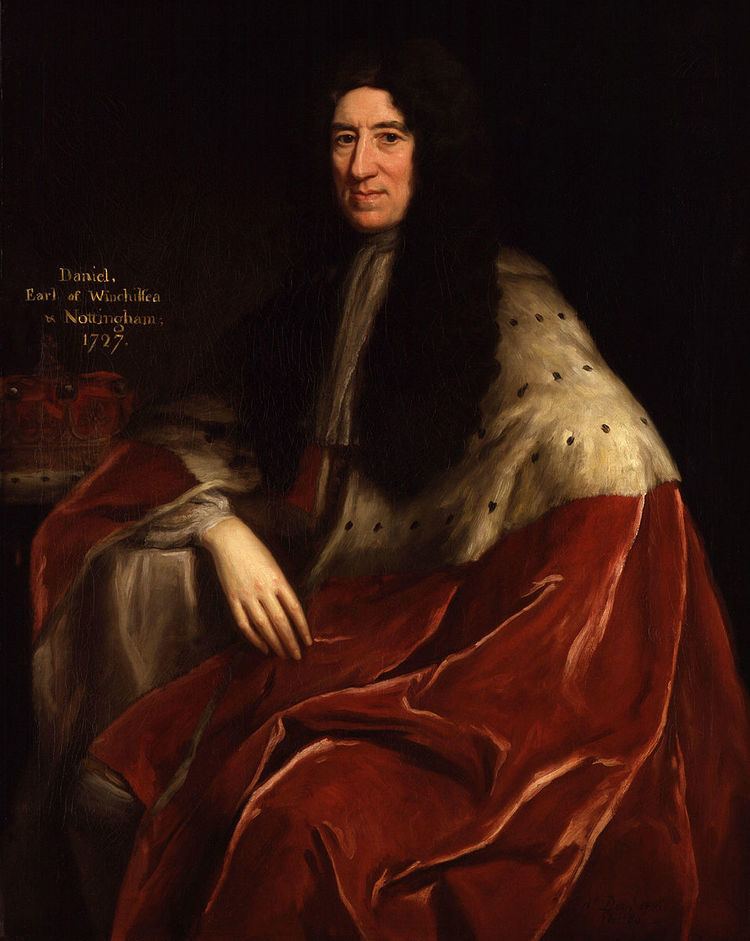Role Statesman | Succeeded by The Duke of Devonshire Preceded by The Earl of Manchester Name Daniel 2nd | |
 | ||
Preceded by The Duke of Buckingham and Normanby Died January 1, 1730, Burley, United Kingdom Children John Finch, Mary Finch, Essex Finch, Henry Finch, Elizabeth Finch, Lady Charlotte Finch, Lady Henrietta Finch Parents Elizabeth Harvey, Heneage Finch, 1st Earl of Nottingham Siblings Heneage Finch, 1st Earl of Aylesford, Elizabeth Finch Grandchildren Charles Watson-Wentworth, 2nd Marquess of Rockingham | ||
Daniel Finch, 2nd Earl of Nottingham, 7th Earl of Winchilsea PC (2 July 1647 – 1 January 1730), was an English Tory statesman during the late seventeenth and early eighteenth centuries.
Contents
Early life
Daniel Finch was the son of Heneage Finch (later the first earl of Nottingham and Lord Chancellor of England) and Elizabeth Harvey, daughter of Daniel Harvey. Little is known about his upbringing. He entered the Inner Temple and Westminster School in 1658, where he boarded for three years at the house of Dr. Richard Busby, the headmaster and his father's tutor at Christ Church, Oxford. Finch went to Christ Church too and the excellence of his studies made his father doubt their authenticity. He matriculated at Christ Church as a Gentleman Commoner on 26 July 1662. In April 1663 his father wrote to him, advising that he "loose not the reputation which I am told you have gayn'd of diligence and sobriety". His father also advised him a month after he had arrived in Oxford "to frequent the publique prayers, and study to reverence and defend, as well as to obey, the Church of England" and when his first Easter away from home was approaching: "Nothing can make you truly wise but such a religion as dwells upon your heart and governs your whole life". However Finch suffered from illness and it may be due to this that he left Oxford without graduating.
Finch went on his Grand Tour from 1665 to 1668, visiting Frankfurt, Munich, Venice, Florence, Naples, Rome, and Paris. After he returned to England he was appointed a Fellow of the Royal Society and his cousin Sir Roger Twysden wrote to Finch's father that "every body speaks him a very gentleman, and one you and your lady are likely to have much comfort in".
Political career
Daniel Finch entered parliament for Lichfield in 1679. He was one of the privy councillors who in 1685 signed the order for the proclamation of the Duke of York, but during the whole of the reign of James II he kept away from the court. At the last moment he hesitated to join in the invitation to William of Orange, and after the flight of James II he was the leader of the party who were in favour of James being King in name and William being regent.
He declined the office of Lord Chancellor under William and Mary, but accepted that of secretary of state, retaining it till December 1693. Under Anne in 1702 he again accepted the same office in the ministry of Lord Godolphin, but finally retired in 1704.
In 1711 during the War of the Spanish Succession, the Tory ministry of Robert Harley was attempting to negotiate peace with France. On 7 December Finch moved the 'No peace without Spain' amendment to the vote of thanks, which condemned any peace with France that left Spain and the West Indies in possession of a member of the House of Bourbon. Finch spoke for one hour, in which he declared "That though he had fourteen children, he would submit to live upon five hundred pounds a year, rather than consent to those dark and unknown conditions of peace".
On the accession of George I he was made Lord President of the Council, but in 1716 he finally withdrew from office. He succeeded to the Earldom of Winchilsea (with which the Nottingham title now became united) on 9 September 1729, and died on 1 January 1730.
Marriages and children
Finch first married on 16 June 1674 Lady Essex Rich, a daughter of Robert Rich, 3rd Earl of Warwick and Anne Cheeke. They had a single daughter: Mary Finch, later married to John Ker, 1st Duke of Roxburghe. Mary was also a lover of William Savile, 2nd Marquess of Halifax, and later married him, following the death of his first wife Elizabeth Grimston.
Finch's second marriage, on 29 December 1685, was to Anne Hatton (1668-1743), daughter of Christopher Hatton, Viscount Hatton. Lady Nottingham was appointed a Lady of the Bedchamber to Queen Mary II in 1691. She had over twenty pregnancies.
The couple had ten surviving children:
Legacy
The Whig historian Lord Macaulay said of Lord Nottingham in 1848:
